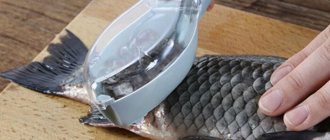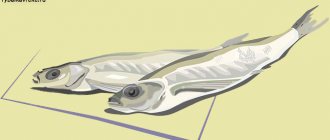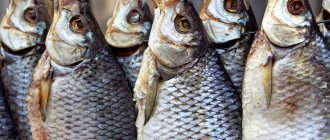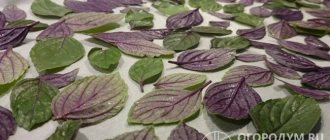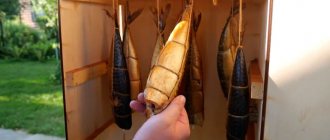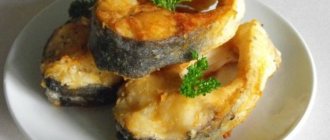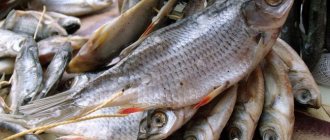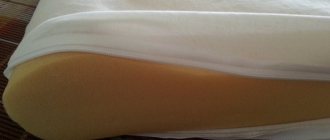And now you have pleased yourself and your loved ones with a luxurious catch. But it is important not only to catch fish, but also to process it - either cook it or put it in a condition suitable for long-term storage. Fortunately, with the advent of freezers, the problem of storing catch has practically been solved, but their capacity is not infinite. And sometimes you want to try something spicy! Therefore, we have not stopped drying fish and happily consuming it in this form.
Well-cured fish is a real delicacy, especially appreciated by lovers of savory dishes. Moreover, many children who cannot stand it fried or boiled enjoy eating dried dietary meat. And today we will tell you how to cook dried fish quickly, efficiently and with pleasure, so that it retains maximum beneficial properties!
Concept of the drying process
Drying any product involves getting rid of excess moisture in one way or another. The same applies to drying fish: moisture is removed from the carcasses, the meat becomes denser, acquiring a piquant aroma. At the same time, fish oil and other nutrients are preserved in the pulp, so this delicacy can be called a storehouse of useful microelements.
This bait provides a rich catch even with a bad bite!
Read more Unfortunately, the excess salt formed during salting somewhat neutralizes the beneficial properties of this product, so you need to thoroughly soak the carcasses before drying. There are technologies that allow you to dry fish without salting, but in our conditions they are of little use. As a rule, this option is used by northern peoples, where climatic conditions allow carcasses to be rid of residual moisture during dry frost and wind.
Theoretically, it is possible to dry salt-free fish in an oven or a special dryer, but does this make sense? Such a semi-finished product requires subsequent soaking and cooking, that is, in this case, the goal is only to preserve a large catch for the purpose of its subsequent use in cooking. A freezer is much better suited for these purposes.
People often ask how the drying process differs from drying? Practically nothing, just drying is a production process, and drying is a handicraft process. In production conditions, it is possible to bring the product to optimal condition while maintaining beneficial properties. If you try, you can achieve a similar result at home. So, let's begin?
Dried vobla: calorie content
Since post-Soviet times, dried and dried roach has been valued as an excellent snack for a foamy drink, without paying attention to its beneficial properties. The fish lives in the Caspian Sea and reaches a weight of 800 g and a length of 30 cm, but most of the specimens that are harvested do not exceed an average of 400 g. Due to their persistent movement against the current during spawning, fishermen often call it the “mad herring”.
When compared with other sea fish, vobla can be classified as a low-fat species, since there are only 2 g of fat per 100 g of weight. But in terms of the amount of protein, which is already 18 g, it occupies a leading position. Complete animal protein contains almost the entire set of essential amino acids that are beneficial to human health.
But this fish is especially valuable for its chromium content, which accounts for 110% per 100 g of the daily requirement for humans. This element helps glucose penetrate through the cell membrane into the cell. Vobla contains a lot of phosphorus and vitamin PP (nicotinic acid).
Many people know that fresh roach is low in calories and are interested in how much is consumed in the dried form. This figure averages 235 kcal per 100 g. But the data depends on the method of harvesting and the time of catching the carcasses.
That is why doctors do not advise consuming the delicacy in large quantities, especially for people who are struggling with excess weight.
Selection and preparation of carcasses
This process works best in the spring (before spawning) and autumn. Firstly, at this time the fish accumulates sufficient reserves of fat, so the meat acquires the best taste. In summer, especially in the first half, representatives of the freshwater ichthyofauna are still recovering from the breeding season, and their meat is a bit tough and not as tasty as we would like.
However, this does not mean that fish dried in summer is not suitable for food at all: it is quite possible to eat it, even with great pleasure. The problem is different: during the warm period, the number of insects goes off scale, wanting to feast on a potential delicacy or use it to reproduce their own kind. Therefore, the issue of protecting drying carcasses from persistent attacks of wasps and flies comes to the fore.
There are no insects in winter, which is good news, but the temperature conditions are far from optimal, and the humidity sometimes goes off scale. During this period, it is recommended to move the process to the balcony (if you have a glazed one) or use artificial heat sources.
In general, the process can be carried out year-round, simply by modifying its conditions. In this case, you can take absolutely any fish. Roach and its subspecies (ram and roach), silver bream, bleak, bream and so on are optimal. Perch, pike perch and pike are somewhat dry, but there are also lovers of the tough meat of the predator. Flat-bodied fish dry best, so it makes sense to cook tench or carp in a different way.
It is necessary to select fresh, undamaged carcasses that have retained the integrity of their scales. The slightest odor or other signs of decomposition will negatively affect the quality of the final product.
Before salting, carcasses must be thoroughly rinsed in running water, paying special attention to the gill slits. To gut the fish or not is a matter of taste and season. There are a few things to consider:
- During the summer, peaceful fish eat a decent amount of algae, so if you do not remove the intestines, which are clogged with all this “good,” the meat will acquire an unwanted bitterness. And in the stomach of a predator you can also find undigested prey - not a very appetizing find when cutting up a dry carcass at the table.
- Large fish with entrails are not dried well using artisanal methods, so it is necessary to remove them. If desired, you can leave the caviar and swim bladder inside. Making cuts along the spine will also help: you will have to pour separate portions of salt into the belly, the above-mentioned cuts and gill slits.
- In autumn and spring, it is better to dry small fish with giblets: this will give the taste of the meat additional piquancy.
Salt impregnation
There are factors that influence salt absorption:
- The higher the presence of fat, the slower salt is absorbed;
- The thicker the fish, the slower the salt passes into the middle;
- The fresher the fish, the slower the salt is absorbed;
- The higher the temperature, the faster the salt is absorbed.
With further drying, the presence of salt has the following effects:
- The higher the salt concentration, the better the water is displaced, and the less water will have to be removed during drying;
- The higher the salt concentration, the less water will need to be removed to obtain a satisfactorily preserved product;
- The higher the salt concentration, the slower the fish will dry out;
- Salt takes moisture from the air and if the humidity is above 75% during drying and further storage, the fish will not dry out. It is able to absorb more moisture.
This applies not only to roach, but also to other fish.
Salting fish
To salt fish before drying, the “wet” method is usually used. Unlike the dry method, it does not involve the outflow of brine (brine) from the container with fish. This way, the carcasses are salted better, throughout the entire volume, and the process proceeds faster. However, we can use any option of your choice:
- Dry . This method requires the use of a container with a “holey” bottom to allow the brine to drain (a basket or plastic box with holes will do). The carcasses are thoroughly sprinkled with salt and stacked in layers (larger at the bottom, smaller at the top). The fish can be covered with a lid on top and loaded, but you can simply cover the top of the container with plastic cling film (with this method, the fish is usually laid open belly up in one layer). Be sure to place a bowl or bucket underneath - the juice will flow there. The time the fish is ready for drying in this case is about a week.
- Wet . Everything is the same as in the previous version, but adjusted for the capacity: in this case, it should have a solid bottom without holes. Sprinkle a thin layer of salt on the bottom of a bowl or pan, put the fish, sprinkle with salt - and so on in layers, as many carcasses as there are. Next, you should select a flat dish or board that covers the fish, but does not cover the container, place it on the top layer and place a weight on it. The best option is a stone or a three-liter jar of water. The carcasses will reach the desired condition in 3-4 days.
- Tuzluchny . This option is the fastest: the fish will be salted in a day or two, depending on the size of the carcasses. In this case, water is boiled, cooled to room temperature, and a strong saline solution is prepared on its basis. Salt should be added gradually, one tablespoon at a time. A raw chicken egg can serve as an indicator of saturation: it does not sink, which means the solution is strong enough. All that remains is to place the fish in it (you can already mate it) and wait the allotted couple of days. It is not necessary to load the carcasses with pressure - the main thing is that they are completely immersed in the brine.
To implement all salting methods, you need to use only coarse salt, or iodized salt. Salted fish must be stored in a cool place, but not in the cold!
Dried pollock
To dry pollock, you need to take the following:
- 1.5 kg pollock;
- 2 tbsp. l. table salt;
- 2 tbsp. l. granulated sugar;
- 1 tsp. mixture of crushed peppers.
Description of the cooking process:
- First, you should wash the pollock, remove all excess, remove the fillets from the bones and cut into thin strips. Then you need to combine granulated sugar with table salt and a mixture of chopped peppers in a deep bowl.
- Then you will need to lay the pollock in layers in a suitable container, cover with a plate, place oppression on top and place in the refrigerator for 3 days.
- After carcassing, the pollock can be squeezed out, placed on a drying rack so that there is a little free space between them, and left in a ventilated room. You can also heat the oven to the minimum temperature, place the fish in it and dry it for 6 hours, leaving the door ajar.
Soaking and preparation for drying
Before drying, salted fish should be tested for doneness. If, when pressed with a finger, a dent forms in the carcass, and the spine makes a characteristic crunch when stretched, the fish has reached the desired condition. Otherwise, you still need to wait a day or two.
If, after salting, the carcasses are not washed and soaked, the fish will be “eaten” by the salt: the meat will turn out to be tough and salty to the point of impossibility. Therefore, it is recommended to rinse each carcass under running water, thoroughly washing the gills and gutted bellies. Then you need to pour water into a large saucepan or bucket and lower the fish into it. Soaking is carried out according to the following principle: the fish should be in the water for as many hours as the number of days it was salted, plus one. The water needs to be changed every hour.
Dried pink salmon with garlic
Ingredients needed for drying:
- 1 large pink salmon;
- 170 g table salt;
- 3 cloves of garlic;
- 1 liter of water;
- 30 g granulated sugar;
- 30 g dill.
Step-by-step preparation scheme:
- First you need to heat the water, add table salt to it and stir until it completely dissolves. Then you need to add granulated sugar and mix thoroughly.
- Next, you will need to peel the garlic, cut it into several pieces, add it to water, wash the dill, chop it, add it to the water, stir, boil over high heat and simmer for 15 minutes.
- Then you need to rinse the pink salmon in cold water, clean it and make cuts in the fillet. Remove the garlic and dill from the cooled brine, place the fillet in it and leave for 15 minutes. Afterwards, take out the fillet and hang it over a plate to drain off excess water.
- Now you can make holes in the plastic container for ventilation, hang the pink salmon and dry it for 2 days. If there is no container, then pink salmon can be hung in the kitchen.
Designs for drying
If you have to dry a small portion of small items, you can do without hanging the carcasses. You need to lay foil on the table or windowsill, and clean paper on it. You need to lay out small change on these layers and cover it on top with light natural fabric or gauze (the last point is relevant in the summer, as it provides protection from flies). The fish will have to be turned over daily, replacing the sodden paper with dry paper as necessary. However, you need to be prepared that the room will smell of fish, and this aroma is not for everyone.
Usually fish is dried using the hanging method. Let's look at the most common options:
- Stretched wire . It is optimal to use stainless steel wire with a small cross-section. Threading is carried out through the eye or gills, maintaining a distance of at least a centimeter between the carcasses. The length of the “garland” is not important: the main thing is that it be possible to stretch it between the supports and securely fasten it. In the summer, protection from flies and wasps in the form of curtain tulle, gauze or light cotton fabric is highly desirable.
- Chalky . In this case, a stiffer wire is used that is capable of holding a given shape. We measure half a meter of wire, bend one end into a loop, string 3-7 fish, form a hook at the free end, fix it on the loop of the other end. Chalks can be hung on nails or hooks, or they can be strung on a crossbar or horizontally stretched wire.
- Frame structures . Frames in the form of parallelepipeds, pyramids, cones, cylinders are made of wood, metal rod, rigid wire, and so on. They are covered with a mosquito net or gauze to protect the drying fish from insects and wind-blown debris. Structures for hanging carcasses are mounted inside: crossbars or hooks for tensioning wire.
Sagging Ambassador
Used for fatty fish. Large representatives of fish are prepared and hung on rods. Then they are placed in a saline solution. The brine should be so salty that the raw potatoes float. The carcasses need to be placed so that they are not too squeezed against each other. After a week, the product can be removed from the brine and, after washing and drying, eaten.
If you catch a big catch in the summer heat far from home, you can do the following:
- Salt the fish carcasses in a large plastic bag.
- Bury the bag in the soil (it doesn’t matter whether it’s sand or earth). The burial depth is 0.7-1 m. The soil layer will serve as protection from heat and at the same time as oppression.
- To prevent moisture from dew or rain from penetrating inside the bag, you need to put a small bag over the neck.
If the fish carcasses are large in size, then they must first be gutted, wiped dry (no washing!), and cut off the head and tail. Rub the outside of each carcass. Sprinkle salt into all cuts and inside. Wrap in clean burlap. You can also use a cloth napkin. Wrap tightly with twine or bandage. Before cooking, the carcasses are soaked using milk or water. Then they cook - boil, stew, fry. The choice of option is to your taste. You can also eat it raw, seasoned like a herring.
Advice. If you catch a large catch in winter and freeze thoroughly on the way home, you should not salt such fish: after defrosting, the tissue structure is already damaged, so it picks up a lot of salt. Because of this, it is very difficult to catch the moment when the carcasses are salted and the fish can be significantly over-salted. In addition, when soaking and hanging, carcasses may disintegrate. It is best to process the catch that has survived freezing and thawing into stew.
Where can you dry fish naturally?
Optimal conditions for drying are low humidity, good ventilation, and protection from direct sunlight. Protection from blowflies, which strive to lay eggs in delicious carcasses, and wasps, which literally gnaw decent pieces out of fish, is also important.
And if you can still put up with wasp passages, then the offspring of the fly swarming inside the carcass automatically makes it unsuitable for ingestion. Therefore, all methods of drying fish outdoors in the warm season must provide appropriate protection in the form of light fabric or a mosquito net.
So, fish can be dried by hanging:
- In the fresh air . In this case, it is important to have a canopy that protects from direct sunlight and precipitation.
- In the attic . The main thing is that it is not too dusty, but otherwise the conditions are ideal.
- In the cellar . The option is optimal for bringing already prepared fish to the desired condition or for a couple of days immediately after hanging. In any case, it will not be possible to dry the carcasses sufficiently - you will have to take them out into the air for a couple of days.
- On the balcony . An option available at any time of the year, and with good glazing - all year round. The main thing is that the fish does not freeze, but is dried.
- In a residential area . The room will have to be ventilated regularly, and household members will have to get used to the piquant smell. The best option is to place the carcasses above the stove in close proximity to the hood and do not forget to turn it on. At the same time, we must not forget that in the first days juice will drip heavily from the fish, so it is better to keep the hanging carcasses on the balcony for a day or two (remembering to place a bowl) or above the bathtub.
Depending on the conditions, the fish is completely dried in 3-5 days, but sometimes it takes a week or more.
Why is roach useful?
During dehydration, carcasses lose more than 50% of moisture, while there is practically no heat treatment, which makes it possible to preserve more useful substances.
In addition to gastronomic pleasure, dried roach brings the following benefits to the body:
- Consuming it in moderation prevents the development of cardiovascular diseases.
- It contains many substances that fight aging.
- A person’s mood improves and the overall tone of the body increases.
- Over time, the rejuvenating effect of the skin will become noticeable.
- The vessels will be cleared of atherosclerotic plaques.
- Calcium helps strengthen tooth enamel and prevent the development of caries.
We must not forget that eating fish serves to prevent the development of malignant tumors in the body.
Important! Do not forget about contraindications, which include kidney failure and serious heart problems. Also, in salted and dried form, if abused, it can cause harm to the body due to ulcers of the gastrointestinal tract, thicken the blood, and disrupt the functioning of the nervous system.
Using household appliances
Using household appliances can make the drying process easier. If you follow some technological nuances, you can successfully dry small carcasses even without salt. Our grandmothers also dried small items in Russian ovens, not bothering at all with cleaning and sometimes salting. Now an alternative to the oven has become a mediocre oven.
The oven drying process looks something like this:
- Let the fish drain thoroughly, leaving it in a colander or laying it out on a paper towel.
- We lay out the prepared carcasses on a baking sheet in one layer, having first lined it with parchment (otherwise you simply won’t wash the baking sheet).
- Turn on the oven to convection mode and set the temperature to low (about 40-50°C). Leave the door slightly open.
- After a couple of hours, turn the carcasses over, protect the heads with foil (if necessary, if they are clearly burning) and keep them in the oven for a few more hours.
- We remove the baking sheet, thread a wire through the eyes and dry the fish overnight under natural conditions.
It is also good to use electric dryers for these purposes, and preference should be given to models specially designed for drying fish and meat. Closed electric dryers are optimal: they do not smell as fragrant during the process.
In a cold room
Before drying, the fish is salted.
For drying you will need the following:
- 2 kg of fish;
- 300 g table salt.
Main stages of preparation:
- First you need to sort the fish, gut large carcasses, and leave small ones whole. Afterwards, you need to rinse the fish, dry it a little and start salting.
- Next, you will need to place a layer of fish in a deep and wide container, sprinkle them with table salt, then add more fish and so on until the carcasses and salt are gone.
- Now you can put the prepared carcasses under pressure, move them to a cold place and leave them for 3-14 days. Afterwards, you need to put the carcasses on twine, piercing the eye sockets, and make bundles of 6 pieces.
- The finished bundles will need to be washed, hung in a cool, ventilated place and covered with gauze. It will take 2 weeks to prepare dried fish.
You can add ground paprika, pepper, turmeric, vegetable oil, horseradish leaves, vinegar, kvass, milk, dill, parsley, bay leaves, lemon juice to the fish.
Dried fish can be served with beer.
Storage of the finished product
Everyone dries the semi-finished product to their taste: some like slightly dried meat, others like it almost wooden-like. In this regard, drying times vary significantly, but rarely does anyone hang carcasses for longer than 5-7 days.
The scales of the finished fish are slightly shiny with fat, but no salt crystals appear on them. The skin is thick, but comes off relatively easily. The meat is elastic and dense, translucent, with a characteristic spicy taste, without bitterness or signs of mold.
In fact, dried fish of this condition, already removed from the wire, is ready to become an original delicacy, but connoisseurs recommend bringing it to perfection in a cool place, wrapping it in culinary parchment or placing it in a linen bag.
For long-term storage, it is better to place the product in the refrigerator, making sure that the container is sealed (otherwise other products will be saturated with the smell of fish). It is good to use a cellar, loggia or other cool place for these purposes. Such fish is stored very well in hermetically sealed glass jars, maintaining freshness and not reaching the stage of stone hardness for several months. And if you pack it in a plastic bag and put it in the freezer, you can treat yourself to a treat a year later.
Primary requirements
Before drying or drying fish, you need to decide how salty it should be.
Now we’ll talk about how much to salt fish for drying, and you can make this delight yourself at home or in the country. If the fish contains ten percent salt, then it is considered lightly salted; if it contains twenty percent or more, it is considered highly salted. The brine (the juice that the fish secretes, mixed with salt) is periodically drained to prevent bacteria from multiplying and spoiling the fish. Fish for drying or drying must be fresh and chilled. Only after this can you start gutting. Salting fish for drying is a very responsible matter. It is necessary to gut the insides so that microbes do not get on the meat.
Practical advice
At the end of our publication, following a good tradition, we give you some practical advice:
- Dishes. When salting using wet methods, it is optimal to use enamel containers or stainless steel utensils. Do not use aluminum under any circumstances - it oxidizes, which negatively affects the taste of the product. Plastic containers are also suitable, but only if you continue to use them only for these purposes: the smell of fish will be indestructible.
- Cargo. You should not use metal objects (dumbbells, weights, etc.) as weights. They are not always sufficiently protected from corrosion, and salt speeds up this process tenfold.
- Flies. Some fishermen moisten the fish with vinegar before drying, but guaranteed protection from flies can only be provided by wrapping it in gauze or netting without a single loophole. But if, despite all the tricks, you are disappointed to find eggs or fly larvae on a failed treat, do not be upset. Wrap the carcass tightly in several layers of newspaper, unwrap it after a few days - and you will get an excellent bait that an even more respectable fish will probably bite on.
- Matches. The abdomen is a particularly problematic place for drying. Therefore, when hanging particularly large specimens, it is recommended to spread out the edges of the abdomen with matches without sulfur or toothpicks inserted there.
- Layers. Particularly large specimens are not very suitable for drying, but fishermen manage to solve this problem. In this case, layers of meat are cut from the carcasses, salted and dried in the usual way, but for a shorter time: a day or two in salt, two to three days for drying.
We hope that, guided by our practical recommendations, you will soon delight your friends and family with your own homemade delicacy!
Fishermen wonder why I’m biting and they’re not?
I’m revealing a secret just for you: it’s all about the miracle bait! More details
Brine recipe
To salt fish, you will need to make a brine, in which you need 350 grams of table salt per liter of water.
The brine is given time to settle until transparent.
For flavor, add a bay leaf, a few peas of allspice and black pepper, a few clove inflorescences, and a dessert spoon of mustard seeds.
These spices will add flavor to the fish and make its smell more attractive. Utensils for salting fish should be enameled, ceramic or stainless steel.

